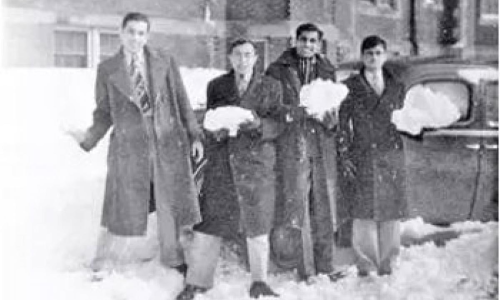Live
- Seal of authenticity for JK crafts by WCC soon
- The online world isn’t always safe
- Markets end in red as weak global cues weigh
- MyVoice: Views of our readers 27th November 2024
- Congress party a victim of its own attitude
- First arrest in RRR Custodial Torture Case: Police arrests Ex-Cop Vijay Paul
- Gukesh claws back with draw against Ding
- BGT: Australia’s top order is major concern, opines Chappell ahead of Adelaide Test
- Hyderabad Police Launch 'Operation Rope' to Address Traffic Issues
- Telangana CM Revanth Reddy Directs Swift Grain Procurement to Aid Farmers
Just In
How the Indian story came into existence; The story so far


How Gandhi‘s India created Indian techies & how at least 100 of them received degrees from MIT before 1947
Wearing urbans in the more paranoid parts of the US today could get you into trouble, so it is ironic to read a US State Department memo from 1945 about how "every Indian" coming to the country should wear a turban, even if he didn't regularly wear one, during the first weeks of "his stay in any community".
This was to show he was Indian, not African-American, and hence should not suffer the discriminations that the latter group had to endure.
The combination of helpful hint, easy use of stereotype and acceptance of racial discrimination is a telling glimpse into the attitudes of that era and that's not even getting into the assumption that, as Ross Bassett notes, "only men would be coming".
The tech-savvy Indian
This is just one of many fascinating details in Bassett's new book The Technological Indian, which could be described as a study of how the image of the Indian techie was created. Bassett is an associate professor of history at North Carolina State University and a specialist in the history of technology.
But he first trained and worked as an engineer, alongside many colleagues of Indian origin. This is now so common as to have become a cliche, with television shows like The Big Bang Theory showing techsavvy Indians. But in high school, Bassett had been interested in Gandhi and read his writings and knew how he was usually shown as deeply opposed to modern technology.
How did Gandhi's India also create the Indian techie? This is a question India often ignores, as when prime ministers from Jawaharlal Nehru to Narendra Modi have simultaneously praised Gandhian values while promoting an anti-Gandhian vision of industrialised India. Or, it is used opportunistically by the emigration-minded as a justification for leaving a country they argue is eternally bound to Gandhi's agrarian, anti-modern mindset.
Bassett found that the issue was more complex. He focused his research on the Massachusetts Institute of Technology (MIT), which has a rich database of student information, thanks to its early founding in 1861, and high reputation, which made it a magnet for technology seekers from around the world. He expected to find many Indian students from the post-Independence era, but what surprised him was to find at least 100 who received MIT degrees before 1947.
Even more surprising, many had links to Gandhi. A disproportionate number came from Saurashtra, like Gandhi, and many were inspired by or received assistance from a close friend of Gandhi's, a man sometimes seen as his representative in the area. This was Devchand Parekh, born two years after Gandhi, whose father was a minister in a local state, just as Gandhi's father had been.
Like Gandhi, Parekh went to the UK to become a lawyer, though at Cambridge rather than London. And it was at Cambridge in 1893 that he had a formative encounter with the economist Alfred Marshall, who told him frankly that young Indians like him should not be coming to the UK to become lawyers; "instead they should go to America — specifically to MIT — to study engineering and then return to India to set up industries that would improve the Indian standard of living".
This was something several Indian leaders, specifically in western India, were also advocating. Bassett starts his book with an account of a meeting held in Pune in 1884 where MM Kunte, headmaster of the Poona High School, had called on Indians to learn "the art of mechanisation" which "has become a Kalpavriksha", the wish-granting tree that would help India progress from its current sad state. It is an appeal that sounds much like PM Modi's recent call to Make in India.
As with the PM's regular evocations of India's past glories, 19th century advocates of progress pointed to the subcontinent's past mastery of technologies like weaving which had first brought foreigners to India to trade, but then unfortunately to conquer and control the means of production. Worse, with the rise of the Industrial Revolution in the West, foreign rulers actively destroyed India's abilities to keep the country in a passive, exploitable agrarian condition. Learning technology was a nationalist imperative.
Source: techgig.com

© 2024 Hyderabad Media House Limited/The Hans India. All rights reserved. Powered by hocalwire.com






